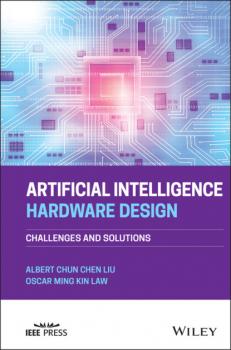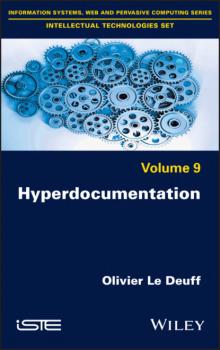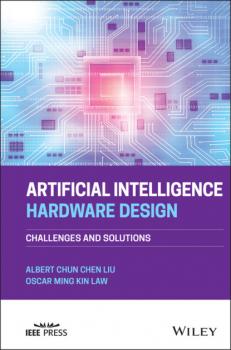John Wiley & Sons Limited
Все книги издательства John Wiley & Sons LimitedArtificial Intelligence Hardware Design
ARTIFICIAL INTELLIGENCE HARDWARE DESIGN Learn foundational and advanced topics in Neural Processing Unit design with real-world examples from leading voices in the field In Artificial Intelligence Hardware Design: Challenges and Solutions , distinguished researchers and authors Drs. Albert Chun Chen Liu and Oscar Ming Kin Law deliver a rigorous and practical treatment of the design applications of specific circuits and systems for accelerating neural network processing. Beginning with a discussion and explanation of neural networks and their developmental history, the book goes on to describe parallel architectures, streaming graphs for massive parallel computation, and convolution optimization. The authors offer readers an illustration of in-memory computation through Georgia Tech’s Neurocube and Stanford’s Tetris accelerator using the Hybrid Memory Cube, as well as near-memory architecture through the embedded eDRAM of the Institute of Computing Technology, the Chinese Academy of Science, and other institutions. Readers will also find a discussion of 3D neural processing techniques to support multiple layer neural networks, as well as information like: A thorough introduction to neural networks and neural network development history, as well as Convolutional Neural Network (CNN) models Explorations of various parallel architectures, including the Intel CPU, Nvidia GPU, Google TPU, and Microsoft NPU, emphasizing hardware and software integration for performance improvement Discussions of streaming graph for massive parallel computation with the Blaize GSP and Graphcore IPU An examination of how to optimize convolution with UCLA Deep Convolutional Neural Network accelerator filter decomposition Perfect for hardware and software engineers and firmware developers, Artificial Intelligence Hardware Design is an indispensable resource for anyone working with Neural Processing Units in either a hardware or software capacity.
Emotionally Naked
Discover effective strategies to help prevent youth suicide In Emotionally Naked: A Teacher’s Guide to Preventing Suicide and Recognizing Students at Risk , trainer, speaker, and suicide loss survivor Anne Moss Rogers, and clinical social worker and researcher, Kimberly O’Brien, PhD, LICSW, empower middle and high school educators with the knowledge and skills to leverage their relationships with students to reduce this threat to life. The purpose of this book is not to turn teachers into therapists but given the pervasive public health problem of suicide in our youth, it’s a critical conversation that all educators need to feel comfortable having. Educators will learn evidence-based concepts of suicide prevention, plus lesser known innovative strategies and small culture shifts for the classroom to facilitate connection and healthy coping strategies, the foundation of suicide prevention. Included is commentary from teachers, school psychologists, experts in youth suicidology, leaders from mental health nonprofits, program directors, and students. In addition, readers will find practical tips, and sample scripts, with innovative activities that can be incorporated into teaching curricula. You’ll learn about: The teacher’s role in suicide prevention, intervention, postvention, collaboration The different and often cryptic ways students indicate suicidality What to do/say when a student tells you they are thinking of suicide Small shifts that can create a suicide-prevention classroom/school environment How to address a class of grieving students and the empty desk syndrome Link to a download of resources, worksheets, activities, scripts, quizzes, and more Who is it for: Middle/high school teachers and educators, school counselors, nurses, psychologists, coaches, and administrators, as well as parents who wish to better understand the complex subject of youth suicide.
Disarmament and Decommissioning in the Nuclear Domain
Following the acquisition of the atomic bomb by five states, the United Nations began drafting several treaties to limit nuclear proliferation. These efforts failed, as four more states also acquired nuclear weapons. In a similar vein, an attempt to limit atomic weapons – primarily within the two superpowers – was initiated.<br /><br />While the number of weapons has decreased, the new bombs now being manufactured are more powerful and more precise, negating any reduction in numbers. In the field of civil nuclear use, all nuclear facilities (reactors, factories, etc.) have a limited lifespan. Once a plant is permanently shut down, these facilities must be decommissioned and dismantled.<br /><br />These operations are difficult, time-consuming and costly. In addition, decommissioning generates large volumes of radioactive waste of various categories, including long-lived and high-activity waste. Risks to the environment and to health are not negligible during decommissioning. The International Atomic Energy Agency (IAEA) and the Nuclear Energy Agency (NEA) of the Organisation for Economic Co-operation and Development (OECD) have produced numerous publications with recommendations. Each state has its own decommissioning strategy (immediate or delayed) and final plan for the site – whether it be returning it to greenfield status or obtaining a nuclear site license with centuries-long monitoring.









